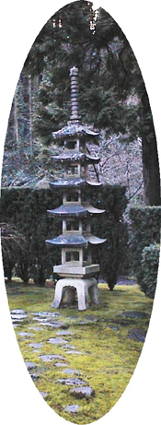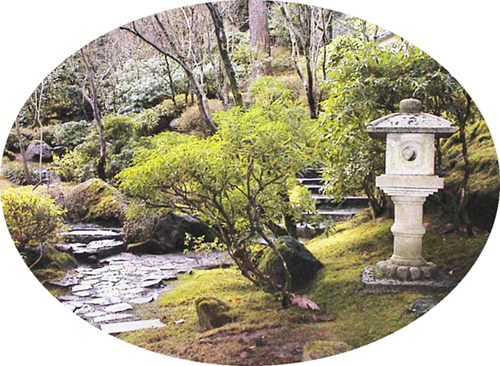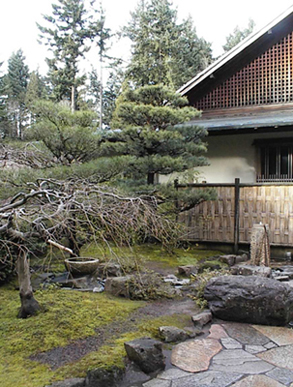| |
|
|
Japanese Garden
|
|
|
|
January 10, 2000
by Absolute Freedom
"Since before anyone remembers
It has been clear
Shining like silver
Though the moonlight penetrates it and the wind ruffles it
No trace of either remains.
Today I would not dare to expound the secret of the stream bed
But I can tell you
That the blue dragon is coiled there."
Muso Kokushi
|

|
|
A short drive to the West Hills of Portland and $3.50 later I am in one of the most supremely peaceful
places I have been in months. The Japanese Garden Society of Oregon was founded in 1962 and in 1963
Professor Takuma Tono designed the garden. In 1967 the Japanese garden opened as a place of quite
beauty, contemplation and reflection. My first trip to the Japanese gardens over Holiday Break was
breathtaking to me. As an observer and student of nature I was in awe of the beauty that was shown to
me so close to home. The peace and serenity that surrounds us everyday we take for granted. The Japanese
garden brings the heavens' down to the earth.
From the waterfalls to the chozubachi (water basins), from the stones to the bridges, every element of
the Japanese gardens symbolizes or represents something else. The Japanese gardens are probably one of
the most interesting pieces of Japanese culture. The stunning gardens are the interpretation of the
creator; they are molded to represent the cross between man and nature. The distinction between the
garden and the surrounding landscape is not evident because they embody each other. The gardens contain
natural and artificial elements, which create the images of man and nature. Each element holds an
individual symbolic meaning. The uniquely beautiful waterfalls, streams and ponds provide a rare,
calming freedom. The passage of the water from the waterfall or stream to the pond symbolizes human
life: birth, growth and death. The sound and appearance of the water changing throughout this course
helps to symbolize the life cycle too, it goes from the rushing waves to a still silence. The Mai-ishi,
Mizukumi-ishi, Mizuage-ishi, and Tetsu-bachi water basins were remarkable.
|

|
|
Hidden in every little corner
you can find an individually different basin. The stone water basins or chozubachi were originally
erected in ancient shrines and temples for the worshipers to rinse their mouths and wash their hands in
as to purify their body and mind. The tsukubai is the same as a chozbachi except a few inches lower to
the ground. Staying in the revelation of nature the water basins are replenished from spout of bamboo
called kakei. A stone lantern is usually near the stone water basin, contributing to the overall
authentic effect of the Japanese garden. Japanese stone lanterns add a mystique and spiritual feeling
to the garden; although the stone lantern is a man-made element, its raw material is stone. The
tobi- ishi (stepping stones) were originally created so that visitors would not have to walk over the
mossy ground. Although they create irregular paths in various patterns, the placements of the stones
are calculated and precise. The Tanzaku walkway led down to another garden of stones, a Zen garden. Zen
gardens or "the gardens of nothingness" provide a place for quiet reflection, relaxation and
contemplation. Since the 16th century they have puzzled, surprised, fascinated and absorbed many people.
Gravel raked into a spiral whirlpool patterns are a motif found in many Zen gardens. As the gravel
suggests the flow of water, it calls the mind into meditation, to focus on the uncertainty of the
present moment. The influence of Zen transformed Japanese gardens from places of amusement and
relaxation to areas for contemplation and solitude. The bridges contained within the gardens promote
spiritual and intellectual meditation. The absence of a handrail emphasizes both the ornate quality
and the spiritual: there is no division between the entity and its surroundings. Hashibasami-no-ishi
are the supports for the bridge; they are created to emphasize the strength of the stone. The Japanese
gardens are a beautiful piece of culture, they represent to unification of man and nature. They show
how we can live as one with the natural world.
|

|

|
I had thought there was
But a single chrysanthemum here.
Who could have planted
The other one made, there in the
Depths of Osawa pond?
By Kokinshu
|

|

"When you depart the Garden you will walk a gentle downhill path
Through the forest on you way to the Antique Gate.
As you pause, look back on your journey
As you have been to a garden
Where Heaven and Earth Meet."
|

|
| |








